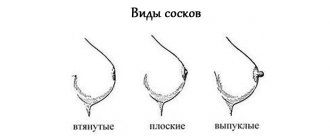After the birth of a baby, there are not only pleasant, but also quite difficult moments in life. To overcome them, you need to understand the baby’s language and learn to negotiate with him. It happens that a baby categorically refuses breastfeeding. Mom begins to panic and tries to feed him from the bottle she has stored. After which the child begins to perceive his mother’s breasts even worse. Why this happens and how to accustom a baby to the breast after a bottle is a question that interests many mothers.
Why does a baby not want to latch on after a bottle?
The reasons can be completely different:
- The mother places the baby incorrectly.
- Child illness (sore throat, nasal congestion, painful teething).
- Bloating.
- Weakness and malaise (often observed in children born prematurely).
- Getting used to an easier way to get food.
- Individual features of the nipple structure, when the baby cannot grasp it correctly.
- Deterioration in the taste of milk during menstruation or after eating certain foods.
- Discomfort due to cold or heat.
- Unusual or pungent smell from mom.
- Stressful state of the mother, fear of pain during feeding.
- Short frenulum in a child.
- Audible or visual distractions.
Don't be angry or offended by the baby. You need to try to understand the reason in order to quickly solve the problem.
Getting your baby used to breastfeeding
In order to wean a baby to the breast, there must be a close mutual connection between mother and baby. They should have enough time to communicate with each other. The baby in his mother’s arms begins to feel protected, which means he calms down and relaxes. He begins to recognize his mother by smell and tactile sensations. When introducing your baby to breastfeeding, you must adhere to the following rules:
No bottles or pacifiers
If there is a need for additional feeding, it is better to feed from a spoon or syringe. Of course, it is more convenient to do this from a bottle, but then it is very difficult to return to breastfeeding. If the baby is already accustomed to drinking from it, then you can try changing the nipple on it with very small holes to make it more difficult for the baby to suck the formula. Before feeding, you can moisten the nipple with milk, then the baby will instinctively reach for the mother's breast. Getting your baby used to breastfeeding after a bottle just requires patience.
Gentle Perseverance
During this period, mom should be constantly nearby. As soon as the baby begins to want to eat or is simply angry, he should be offered the breast. If he continues to refuse and demand a bottle, you should not show your strength and hold the baby’s head by force. Don't yell at him or shake him. Mom is love and care. You can’t boycott the baby: don’t let him eat and ignore his crying. The baby may become withdrawn, and the problems associated with this will appear at an older age.
Ideal conditions for faster bottle weaning
The baby is used to his mother, calms down when she is near, but stubbornly continues to refuse the breast? To train him, you need to create comfortable conditions. Every mother should choose the most comfortable position for breastfeeding. It’s worth experimenting: lying down, sitting, using a pillow.
It is better to dim the lights and exclude all extraneous sounds. If there is someone else in the house, ask him not to walk nearby or make noise during feeding. If there are physiological problems, then you need to solve them as quickly as possible. To ensure that the cosmetic features of the nipple do not affect breastfeeding, you can use special silicone attachments.
If the problem cannot be solved on your own, you should consult a pediatrician. It will help you figure it out and solve the problem faster. Different methods may work in each individual case. Mom should also listen to her intuition and heart. You need to watch the baby, he himself will tell you what is bothering him.
How to resume breastfeeding?
Despite the variety of factors that provoke a child’s refusal to suckle at the breast and get used to the bottle, the mechanism of decisions and actions is always the same.
To eliminate the main cause and additional factors, it will take quite a lot of time and mother’s patience. The ideal option is to throw all the mother’s energy into weaning the baby off the bottle and returning to breastfeeding.
That is why it is extremely necessary to get the support of household members, since all other everyday problems should fall on the shoulders of the spouse, adult first-born child or grandmothers. Of course, you need to warn about this in advance.
What exactly should a mother do? Listen to the advice of breastfeeding experts and implement them correctly. Experts offer the following useful recommendations.
- It is necessary to put aside everything that the child can suck, of course, with the exception of the mammary glands. Such a radical step solves two problems at once. First of all, it is natural for a baby to strive to suck the breast, so in the absence of a pacifier and bottle, he will take the breast, which is what the mother wants. In addition, the factor of nipple disorientation is removed. The baby will remember how to grasp the nipple correctly and will return to the mother’s breast.
- A woman needs to constantly maintain close physical contact. This advice from experts on breastfeeding also applies to breastfeeding. When a mother carries her baby in her arms and touches his body with her skin, this leads to some useful responses. In the mother's body, when the baby is applied to the mammary gland, the amount of oxytocin increases, as a result of which milk is released more strongly. The baby develops the warmest feelings for his mother, he feels her love, protection and tenderness. That is, breastfeeding is the most important condition for optimal psychological health of children.
- For a certain period of time, it is better to remove household members from caring for the child. It is better to ask them for help in household chores, and only the mother is responsible for feeding, putting them to bed, performing water procedures, rocking them to sleep and carrying them in her arms. However, if the baby begins to cry when changing a diaper or after bathing, it is better to entrust this task to the father or another loved one. The point of such manipulations is that the child should not have any negative associations with his mother. This will significantly contribute to natural feeding.
- Experts on breastfeeding strongly advise reducing the time spent in public places while weaning off the bottle. This method involves constantly staying at home, in a familiar environment, next to your beloved mother. At the very beginning of returning to natural feeding, experts recommend excluding visits to guests, the hospital, shortening the duration of festivities, and even abandoning them altogether.
- It is imperative to give breastfeeding when the baby needs it most. So, a newborn is simply “obliged”, due to natural reflexes, to fall asleep with his mother’s breast in his mouth. That is why, before falling asleep, children usually do not resist breastfeeding. Another convenient time period is immediately after the opening of children’s eyes, when the child has not yet “activated”. In addition, nighttime meals are also beneficial for breastfeeding. They increase milk secretion and help restore the correct sucking reflex.
- A nursing woman needs to do everything to ensure that the baby feels comfortable and as comfortable as possible when receiving milk. Mom should try to feed the baby in any position - sitting, standing and lying on a barrel. Another option is to use a special pillow. In addition, it is necessary to eliminate any distraction - the sounds of the TV, for example. If you have cracks in your breasts or problems with your nipples, you can first try feeding your baby using special pads on which you can drip a little milk.
- There is no need to insist if the child categorically refuses the breast and reacts extremely negatively to the offer to suckle milk. You cannot be irritated, much less force your baby to grab the nipple by force. To promote natural feeding, you should show maximum tenderness, patience and affection. In case of a whim, the mother should simply calm the baby down and try again after some time.
- If the child has become accustomed to the bottle, it is necessary to return to natural feeding as soon as possible. However, a new parent needs to behave correctly, that is, avoid the bottle as much as possible. In the absence of other options, the child will simply be forced to satisfy all his reflexes through the mother's mammary glands. In the future, this will help establish a normal food intake process.
- Breastfeeding experts also advise sleeping with your baby. Falling asleep together promotes close interaction almost every minute, and also provides the baby with unlimited access to breast milk at night - precisely at that time period when the milk secretion is best separated. At the same time, breastfeeding promotes optimal rest, since the woman does not have to jump up due to the baby's crying.
The sucking reflex is an innate ability of a newborn baby. It is so natural that breastfeeding is quite easy to establish.
However, this must be done correctly, having first established the reason for refusing breastfeeding and getting used to the bottle.
If the proposed steps did not help to retrain the baby, you should definitely contact your pediatrician. It is possible that the problems are associated with the anatomical features of the baby's oral cavity, intolerance to breast milk, or some other serious illness.
The child is accustomed to the bottle, how to return to the breast painlessly?
The first thing a mother does after the birth of her baby is to put him to her breast. But there are also situations when this did not happen for a number of reasons. The newborn has to be bottle-fed. When the mother manages to put the child to her breast, he turns away. It is much harder for the baby to get milk from her, so he tries to establish his own rules.
But all is not lost. Breastfeeding can be resumed. Mom needs to do her best to ensure that the quantity and quality of milk meets the baby’s needs. The first thing to do is hide the bottle. Keep nipples away too. Breasts are the solution to all problems: hunger, melancholy, resentment, anger. You can supplement with a spoon or syringe. Adhering to this tactic, after a few days the baby should give up.
If the baby is able to suck milk for 10 minutes or more, then you can reduce the amount of supplementary feeding and continue in the same direction.
After a bottle, the baby is reluctant to take the breast. Pediatricians recommend holding the baby when he falls asleep or does not have time to wake up. His consciousness is still asleep, and he will not resist so much. The first time he can just hold the nipple in his mouth until he finally figures it out. No feeding by the hour, only according to the baby’s needs.
A child is a person with whom you can come to an agreement, but sometimes it can be very difficult to teach him to start doing something. You need to constantly remind yourself of the existence of your mother’s breasts, without turning the process into an imposition.
All work to restore breastfeeding falls on the mother’s shoulders. Experts can only give advice and recommendations. Family members should also participate in this process. In order for the mother to be as restrained and calm as possible, she needs to rest more and spend time with the child. During this period, it is better to distribute household responsibilities among other family members. The main thing is not to give up, but to calmly and confidently pursue your goal.
If you're interested in articles like this, check out our parenting tips section.
How to throw away the bottle and return to breastfeeding
In the family where a child was born, gifts always appear. Among the bags and boxes in bright packaging, as a rule, we find bottles and nipples... Why “as a rule”? Why do they initially bring something to mommy that can deceive the baby and replace her mother, even if only temporarily?
Babies are often and happily ready to devote all their “free” time to suckling their mother’s breast. And this is not a habit or spoilage - it is a reflex necessary for survival. This reflex appears during the period of intrauterine development, it takes part in the formation of stable connections in the child’s brain, affects the functions of the gastrointestinal tract and metabolism. It also affects the development of the emotional sphere. This means that we can say that children who are allowed to suck to their heart’s content grow up mentally healthy.
We have long known that everything in our body is logical and obeys internal laws and orders. And if the baby needs to satisfy the need for sucking, there is always a mother’s breast provided by nature in his environment. It is important for babies not only to eat - children look to their mother’s breast for protection, warmth, comfort, trust and development. Anyone who has at least once seen the interaction between a mother and baby during breastfeeding will understand me!
And so that the baby’s body does not get tired of frequent breastfeeding, nature has arranged it so that milk contains a lot of useful components: breast milk enzymes that help digest it, and special substances that stimulate the activity of the baby’s own enzymes, and much more. Milk does not linger like a mixture in the stomach - after 15-20 minutes the intestines begin to actively work, which is also adapted for the continuous supply of milk.
What should you do if for some reason your baby has been receiving formula from a bottle for some time? How to return to natural feeding? Learn the steps you can take on your way from bottle back to breast.
Step 1: Prepare yourself for the possibility. If you are ready and motivated, you can do it!
Also prepare your husband and relatives - tell them what exactly you will do, what you need help with, and what absolutely cannot be allowed during this period (for example, “regretting” feeding the baby secretly from a bottle).
It is important to get support and understanding that the bottle will now become... a vase - it was not in vain that they bought it!
Offer your baby the breast gently. Start with the baby simply licking the nipple, which the mother can lubricate with the usual mixture or her own milk. Before feeding, be sure to “warm” the breasts with a light massage (milk will flow better, heat stimulates the hormone oxytocin, which “opens” the ducts). The first step is for the baby to grab the areola and start sucking. It’s good for babies to latch on when they’re sleepy, so be more persistent at night.
Check to see if your baby is latching on correctly. Teasing the baby with drops of milk on the nipple (hold the nipple at the level of the nose, the baby is completely turned to the mother “belly to stomach”, and not just turned his head to the breast), wait until he stretches, opens his mouth wide, and with a confident movement direct the nipple to to the sky - while holding the baby close to you. Almost the entire nipple circle should now be in the baby's mouth. This way he will be able to press well on the lobules of the mammary gland with his tongue and “extract” milk. And the nipple is not injured.
If bottle feeding has been a long time, understand that the disappearance of the bottle is stressful, and you need to be gentle and patient, because you are changing the usual course of events. It is especially important at this moment to trust yourself, the natural instincts and experience of those mothers who managed to return to natural feeding. Be consistent in your decision and do not change tactics.
Step 2. You can choose to switch directly to breastfeeding, without supplementary feeding at all.
You have milk! Its amount will increase by the third day of active breastfeeding. At the same time, try to direct your attention to the baby, and not to the breast.
If you decide not to supplement with formula, the main task will be to control the number of urinations per day. There should be either 12 wet diapers (we don’t use disposable diapers), or counting wet filled diapers - there should be at least 4 of them. Urine has no color and a strong smell. The baby poops at least once a day or two (liquid stool with white “milky” grains, without obvious mucus and green-brown tints). In some cases, children pee more and poop once every three to four days - monitor the general condition of the child. What is important to pay attention to? The baby's sleep is stable, does not interrupt every 10-15 minutes and can last at least one hour at least three times a day. The total weight gain per week ranges from 100 to 250 g. There is no vomiting or frequent active regurgitation. The child is generally in a good mood and active.
Control feeding is very often not indicative, since the mother at this moment is in changed living conditions and, as a rule, in a psychologically uncomfortable state.
Correct control weighing involves the following scheme: we weigh “today at 12 noon before feeding”, the next weighing is carried out no earlier than three days later, and ideally a week later at the same conventional 12 noon before feeding. We look at the gain in three days (ideally, in a week) at the rate of “monthly weight gain - 600-800 g.”
So, if all of the above does not cause you alarm, then everything is going as the baby’s body requires. Do not panic!
Supplementary feeding is recommended if there are clear symptoms of a lack of mother's milk and the child's clearly restless behavior after and in between feedings.
Step 3. In 10 days you can really forget about the bottle completely, just throw it away and don’t remember!
Don't forget to get rid of the pacifier along with the bottle - we don't need competitors!
The principle of sucking a pacifier is similar to the principle of sucking a bottle. In addition, the child often clamps the pacifier between his gums, so the use of this “gift” changes the child’s latch on the breast.
We hide, or better yet, throw away pacifiers and pacifiers.
There is only breasts, and nothing else - you are in the desert, and the supermarket is on another planet!
Step 4. In prolonged cases, step-by-step avoidance of supplementary feeding is used, using a spoon or cup instead of a bottle.
If there was a lot of supplementary feeding, its amount should be removed gradually. Convenient formula - minus 10 ml per supplementary feeding (from 30 to 50 ml per day). At the same time, we also monitor “wet diapers.”
We offer supplementary feeding after breastfeeding, using a spoon or cup (in some cases, a syringe without a needle). It’s good to give your own expressed milk instead of formula.
Step 5. Many mothers have succeeded - and you can too!
The baby's activity at the breast can be increased by lightly massaging the palms, fingers, heels and ears during feeding - the baby does not fall asleep, because the cerebral cortex is stimulated. Secondary benefit - we increase the activity of brain neural connections, as a result we obtain the basis for intellectual development. Songs and conversations, ditties and jokes have the same secondary benefit for the development of the child.
Remember that babies love to “test” the reliability of their mother’s promises, and the presence of breasts with milk can also be verified. Your task, by transferring your baby to full breastfeeding, is to “fix” the result. This will take another week or two.
Believe me, compared to growing up and the length of his entire life, the first six to seven months of a baby’s life are worth spending at his mother’s breast, and not with a bottle in his mouth and seven nannies!
Step 6. To increase milk supply and establish close contact with the baby, it is recommended to use the “Nest Method”.
The nest is arranged as follows. For three to four days, put yourself and your baby in bed, making it as comfortable as possible. We live together day and night, we feed lying down or half-sitting - the main thing is to be comfortable!
We make trips from the nest to the toilet, bathroom and kitchen.
These days we don’t bathe the baby or take her for walks unless necessary, and she, as a rule, doesn’t show up. In extreme cases, an assistant can replace the mother during a walk, allowing her to sleep freely for no more than 1.5 hours.
We feed on demand - the more often the better. The main goal is to show the baby that the mother is nearby, is not going anywhere, and she has enough milk, and no one is offering other options. We restore the supply-demand chain and prove that mom can be trusted - she loves and cares!
No guests, no loud and abrupt situations in the house, we do not introduce new foods to the mother, we wear clothes and hairstyles that are familiar to the baby (!).
The feeding time of a child ranges from 15 to 50 minutes, depending on many factors - the child, naturally, chooses the time.
If the baby cries, first calm him down and then offer the breast.
Step 7. If necessary, supplement with your own expressed milk from a spoon or cup, depending on the baby’s age.
When to pump? We feed the child often and little by little. The time spent at the breast is about 20-30 minutes; after the baby is tired, we pump and can immediately supplement the feeding. At this time, the child is next to you or your husband will hold him like a “soldier.”
Be sure to feed at night, especially between 5 and 7 am - this is the time of active prolactin production.
In extreme cases, if the child does not want to breastfeed frequently and sleeps for 2-3 hours between feedings, it is recommended to pump every half hour for 2 days, at least 30 ml.
Step 8. Contact a lactation consultant for support.
Today, almost all cities have qualified breastfeeding consultants. You can invite one of them home, meet in support groups, or communicate over the phone. The consultant will help you choose the right tactics for your situation, support you during the transition stage, give a massage to stimulate lactation, and be “next to you.”
Step 9. Mom’s mood greatly influences the transition, and it’s also important to get enough sleep!
If you have the opportunity to receive physical support from your husband, mother or mother-in-law, do not refuse. Their help is to make you comfortable while you take care of the child.
Don't feel guilty or despair. Believe in your capabilities and your baby's healthy instinct. Hormones produced during negative emotions inhibit milk production.
You make a decision and take action. You need the support of your loved ones and faith that everything will work out. Kids always thank their mother for their health and good mood!
Be sure that you are a good mother and that you are giving your baby what she needs.
After all, it’s so natural: warm breasts, smells of milk and mother, mother hugs, smiles - what could be more comfortable?!











